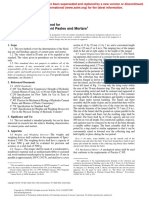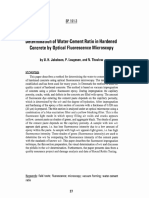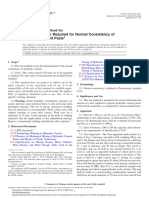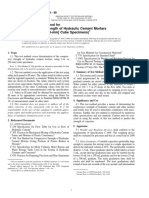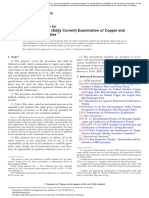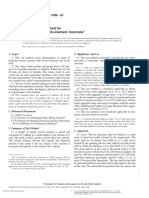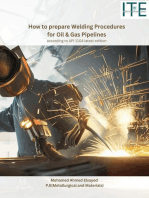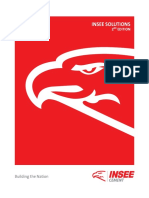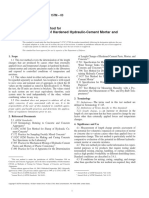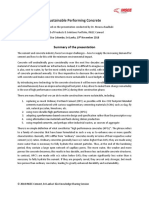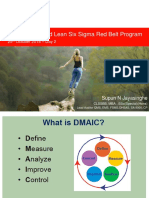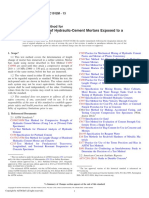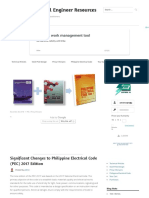Fineness of Hydraulic Cement by Air-Permeability Apparatus: Standard Test Methods For
Fineness of Hydraulic Cement by Air-Permeability Apparatus: Standard Test Methods For
Uploaded by
KalindaMadusankaDasanayakaCopyright:
Available Formats
Fineness of Hydraulic Cement by Air-Permeability Apparatus: Standard Test Methods For
Fineness of Hydraulic Cement by Air-Permeability Apparatus: Standard Test Methods For
Uploaded by
KalindaMadusankaDasanayakaOriginal Title
Copyright
Available Formats
Share this document
Did you find this document useful?
Is this content inappropriate?
Copyright:
Available Formats
Fineness of Hydraulic Cement by Air-Permeability Apparatus: Standard Test Methods For
Fineness of Hydraulic Cement by Air-Permeability Apparatus: Standard Test Methods For
Uploaded by
KalindaMadusankaDasanayakaCopyright:
Available Formats
Designation: C204 − 11 American Association State
Highway and Transportation Officials Standard
AASHTO No.: T 153
Standard Test Methods for
Fineness of Hydraulic Cement by Air-Permeability
Apparatus1
This standard is issued under the fixed designation C204; the number immediately following the designation indicates the year of
original adoption or, in the case of revision, the year of last revision. A number in parentheses indicates the year of last reapproval. A
superscript epsilon (´) indicates an editorial change since the last revision or reapproval.
1. Scope* C670 Practice for Preparing Precision and Bias Statements
1.1 This test method covers determination of the fineness of for Test Methods for Construction Materials
hydraulic cement, using the Blaine air-permeability apparatus, E832 Specification for Laboratory Filter Papers
in terms of the specific surface expressed as total surface area 2.2 Other Document:
in square centimetres per gram, or square metres per kilogram, No. 114 National Institute of Standards and Technology
of cement. Two test methods are given: Test Method A is the Standard Reference Material3
Reference Test Method using the manually operated standard BS 4359: 1971 British Standard Method for the Determina-
Blaine apparatus, while Test Method B permits the use of tion of Specific Surface of Powders: Part 2: Air Perme-
automated apparatus that has in accordance with the qualifica- ability Methods4
tion requirements of this test method demonstrated acceptable
TEST METHOD A: REFERENCE METHOD
performance. Although the test method may be, and has been,
used for the determination of the measures of fineness of 3. Apparatus
various other materials, it should be understood that, in
general, relative rather than absolute fineness values are 3.1 Nature of Apparatus—The Blaine air-permeability ap-
obtained. paratus consists essentially of a means of drawing a definite
1.1.1 This test method is known to work well for portland quantity of air through a prepared bed of cement of definite
cements. However, the user should exercise judgement in porosity. The number and size of the pores in a prepared bed of
determining its suitability with regard to fineness measure- definite porosity is a function of the size of the particles and
ments of cements with densities, or porosities that differ from determines the rate of airflow through the bed. The apparatus,
those assigned to Standard Reference Material No. 114. illustrated in Fig. 1, shall consist specifically of the parts
described in 3.2-3.8.
1.2 The values stated in SI units are to be regarded as the
standard. 3.2 Permeability Cell—The permeability cell shall consist
of a rigid cylinder 12.70 6 0.10 mm in inside diameter,
1.3 This standard does not purport to address all of the constructed of austenitic stainless steel. The interior of the cell
safety concerns, if any, associated with its use. It is the shall have a finish of 0.81 µm (32 µin.). The top of the cell shall
responsibility of the user of this standard to establish appro- be at right angles to the principal axis of the cell. The lower
priate safety and health practices and determine the applica- portion of the cell must be able to form an airtight fit with the
bility of regulatory limitations prior to use. upper end of the manometer, so that there is no air leakage
2. Referenced Documents between the contacting surfaces. A ledge 1⁄2 to 1 mm in width
shall be an integral part of the cell or be firmly fixed in the cell
2.1 ASTM Standards:2 55 6 10 mm from the top of the cell for support of the
A582/A582M Specification for Free-Machining Stainless perforated metal disk. The top of the permeability cell shall be
Steel Bars fitted with a protruding collar to facilitate the removal of the
cell from the manometer.
1
This test method is under the jurisdiction of ASTM Committee C01 on Cement
NOTE 1—Specification A582/A582M Type 303 stainless steel (UNS
and is the direct responsibility of Subcommittee C01.25 on Fineness.
Current edition approved June 1, 2011. Published August 2011. Originally
designation S30300) has been found to be suitable for the construction of
approved in 1946. Last previous edition approved in 2007 as C204 – 07. DOI:
10.1520/C0204-11.
2 3
For referenced ASTM standards, visit the ASTM website, www.astm.org, or Available from National Institute of Standards and Technology (NIST), 100
contact ASTM Customer Service at service@astm.org. For Annual Book of ASTM Bureau Dr., Stop 1070, Gaithersburg, MD 20899-1070, http://www.nist.gov.
4
Standards volume information, refer to the standard’s Document Summary page on Available from British Standards Institute (BSI), 389 Chiswick High Rd.,
the ASTM website. London W4 4AL, U.K., http://www.bsi-global.com.
*A Summary of Changes section appears at the end of this standard
Copyright © ASTM International, 100 Barr Harbor Drive, PO Box C700, West Conshohocken, PA 19428-2959. United States
Copyright by ASTM Int'l (all rights reserved); 1
C204 − 11
FIG. 1 Blaine Air-Permeability Apparatus
the permeability cell and the plunger. plunger shall be provided with a collar such that when the
3.3 Disk—The disk shall be constructed of noncorroding plunger is placed in the cell and the collar brought in contact
metal and shall be 0.9 6 0.1 mm in thickness, perforated with with the top of the cell, the distance between the bottom of the
30 to 40 holes 1 mm in diameter equally distributed over its plunger and the top of the perforated disk shall be 15 6 1 mm.
area. The disk shall fit the inside of the cell snugly. The center 3.5 Filter Paper—The filter paper shall be medium
portion of one side of the disk shall be marked or inscribed in retentive, corresponding to Type 1, Grade B, in accordance
a legible manner so as to permit the operator always to place with Specification E832. The filter paper disks shall be circular,
that side downwards when inserting it into the cell. The with smooth edges, and shall have the same diameter (Note 2)
marking or inscription shall not extend into any of the holes, as the inside of the cell.
nor touch their peripheries, nor extend into that area of the disk
NOTE 2—Filter paper disks that are too small may leave part of the
that rests on the cell ledge. sample adhering to the inner wall of the cell above the top disk. When too
3.4 Plunger—The plunger shall be constructed of austenitic large in diameter, the disks have a tendency to buckle and cause erratic
stainless steel and shall fit into the cell with a clearance of not results.
more than 0.1 mm. The bottom of the plunger shall sharply 3.6 Manometer—The U-tube manometer shall be con-
meet the lateral surfaces and shall be at right angles to the structed according to the design indicated in Fig. 1, using
principal axis. An air vent shall be provided by means of a flat nominal 9-mm outside diameter, standard-wall, glass tubing.
3.0 6 0.3 mm wide on one side of the plunger. The top of the The top of one arm of the manometer shall form an airtight
Copyright by ASTM Int'l (all rights reserved); 2
C204 − 11
connection with the permeability cell. The manometer arm oil just prior to adding the mercury. Level the mercury with the
connected to the permeability cell shall have a midpoint line top of the cell by lightly pressing a small glass plate against the
etched around the tube at 125 to 145 mm below the top side mercury surface until the glass is flush to the surface of the
outlet and also others at distances of 15 6 1 mm, 70 6 1 mm, mercury and rim of the cell, being sure that no bubble or void
and 110 6 1 mm above that line. A side outlet shall be provided exists between the mercury surface and the glass plate.
at 250 to 305 mm above the bottom of the manometer for use Remove the mercury from the cell and measure and record the
in the evacuation of the manometer arm connected to the mass of the mercury. Remove one of the filter disks from the
permeability cell. A positive airtight valve or clamp shall be cell. Using a trial quantity of 2.80 g of cement (Note 3)
provided on the side outlet not more than 50 mm from the compress the cement (Note 4) in accordance with 4.5 with one
manometer arm. The manometer shall be mounted firmly and filter disk above and one below the sample. Into the unfilled
in such a manner that the arms are vertical. space at the top of the cell, add mercury, remove entrapped air,
3.7 Manometer Liquid—The manometer shall be filled to and level off the top as before. Remove the mercury from the
the midpoint line with a nonvolatile, nonhygroscopic liquid of cell and measure and record the mass of the mercury.
low viscosity and density, such as dibutyl phthalate (dibutyl 4.2.3 Calculate the bulk volume occupied by the cement to
1,2-benzene-dicarboxylate) or a light grade of mineral oil. The the nearest 0.005 cm3 as follows:
fluid shall be free of debris. V 5 ~ W A 2 W B ! /D (2)
3.8 Timer—The timer shall have a positive starting and where:
stopping mechanism and shall be capable of being read to the V = bulk volume of cement, cm3,
nearest 0.5 s or less. The timer shall be accurate to 0.5 s or less WA = grams of mercury required to fill the cell, no cement
for time intervals up to 60 s, and to 1 % or less for time being in the cell,
intervals of 60 to 300 s. WB = grams of mercury required to fill the portion of the cell
not occupied by the prepared bed of cement in the cell,
4. Calibration of Apparatus and
4.1 Sample—The calibration of the air permeability appara- D = density of mercury at the temperature of test, Mg/m3
tus shall be made using the current lot of NIST Standard (see Table 1).
Reference Material No. 114. The sample shall be at room 4.2.4 Make at least two determinations of bulk volume of
temperature when tested. cement, using separate compactions for each determination.
The bulk volume value used for subsequent calculations shall
4.2 Bulk Volume of Compacted Bed of Powder—Determine
be the average of two values agreeing within 60.005 cm3.
the bulk volume of the compacted bed of powder by physical
Note the temperature in the vicinity of the cell and record at the
measurement or by the mercury displacement method as
beginning and end of the determination.
follows:
4.2.1 Bulk Volume Determination by Physical NOTE 3—It is not necessary to use the standard sample for the bulk
Measurement—Place two filter papers in the permeability cell. volume determination.
NOTE 4—The prepared bed of cement shall be firm. If too loose or if the
Use a rod slightly smaller than the diameter of the cell to press cement cannot be compressed to the desired volume, adjust the trial
down the edges of the filter paper flat on the perforated disk. quantity of cement used.
Determine the dimensions of the permeability cell, in cm, using
4.3 Preparation of Sample—Enclose the contents of a vial
a measuring device readable to 0.001 cm. Measure the inside
of the standard cement sample in a jar, approximately 120 cm3
diameter of the permeability cell near the perforated disk.
(4 oz), and shake vigorously for 2 min to fluff the cement and
Measure the depth of the cell and the length of the plunger.
break up lumps or agglomerates. Allow the jar to stand
Take three measurements of each dimension and use the
unopened for a further 2 min, then remove the lid and stir
average value of each dimension to calculate the bulk volume
gently to distribute throughout the sample the fine fraction that
as follows:
has settled on the surface after fluffing.
V 5 π r 2h (1)
where:
TABLE 1 Density of Mercury, Viscosity of Air (η), and œ η at
V = bulk volume occupied by sample, cm3, Given Temperatures
r = diameter cell/2, cm, and Density of
h = cell depth – plunger length, cm. Room Viscosity of Air, η
Mercury, œη
Temperature, °C µPa·s
Mg/m 3
4.2.2 Bulk Volume Determination by the Mercury Displace-
18 13.55 17.98 4.24
ment Method—Place two filter paper disks in the permeability 20 13.55 18.08 4.25
cell, pressing down the edges, using a rod having a diameter 22 13.54 18.18 4.26
slightly smaller than that of the cell, until the filter disks are flat 24 13.54 18.28 4.28
on the perforated metal disk; then fill the cell with mercury, 26 13.53 18.37 4.29
ACS reagent grade or better, removing any air bubbles adher- 28 13.53 18.47 4.30
ing to the wall of the cell. Use tongs when handling the cell. If 30 13.52 18.57 4.31
32 13.52 18.67 4.32
the cell is made of material that will amalgamate with mercury, 34 13.51 18.76 4.33
the interior of the cell shall be protected by a very thin film of
Copyright by ASTM Int'l (all rights reserved); 3
C204 − 11
4.4 Mass of Sample—The mass of the standard sample used providing data in accordance with the precision and bias
for the calibration test shall be that required to produce a bed statement in Section 8.
of cement having a porosity of 0.500 6 0.005, and shall be 4.7.2 If any loss in the manometer fluid occurs, recalibrate
calculated as follows: starting with 4.5, or
W 5 ρV ~ 1 2 ε ! (3) 4.7.3 If a change is made in the type or quality of the filter
paper used for the tests.
where:
W = grams of sample required, NOTE 8—It is suggested that a secondary sample be prepared and used
ρ = density of test sample (for portland cement a value of as a fineness standard for the check determinations of the instrument
3.15 Mg/m3 or 3.15 g/cm3 shall be used), between regular calibrations with the standard cement sample.
V = bulk volume of bed of cement, cm3, as determined in
accordance with 4.2, and 5. Procedure
ε = desired porosity of bed of cement (0.500 6 0.005) 5.1 Temperature of Cement—The cement sample shall be at
(Note 5). room temperature when tested.
NOTE 5—The porosity is the ratio of volume of voids in a bed of cement
to the total or bulk volume of the bed, V. 5.2 Size of Test Sample—The weight of sample used for the
4.5 Preparation of Bed of Cement— Seat the perforated disk test shall be the same as that used in the calibration test on the
on the ledge in the permeability cell, inscribed or marked face standard sample, with these exceptions: When determining the
down. Place a filter paper disk on the metal disk and press the fineness of Type III or other types of fine-ground portland
edges down with a rod having a diameter slightly smaller than cement whose bulk for this mass is so great that ordinary
that of the cell. Measure the mass to the nearest 0.001 g the thumb pressure will not cause the plunger collar to contact the
quantity of cement determined in accordance with 4.4 and top of the cell, the weight of the sample shall be that required
place in the cell. Tap the side of the cell lightly in order to level to produce a test bed having a porosity of 0.530 6 0.005. When
the bed of cement. Place a filter paper disk on top of the cement determining the fineness of materials other than portland
and compress the cement with the plunger until the plunger cement, or if for a portland cement sample one of the required
collar is in contact with the top of the cell. Slowly withdraw the porosities cannot be attained, the mass of the sample shall be
plunger a short distance, rotate about 90°, repress, and then adjusted so that a firm, hard bed is produced by the compacting
slowly withdraw. Use of fresh paper filter disks is required for process. In no case, however, shall more than thumb pressure
each determination. be used to secure the proper bed, nor shall such thumb pressure
be used that the plunger “rebounds” from the cell top when
4.6 Permeability Test : pressure is removed.
4.6.1 Attach the permeability cell to the manometer tube,
making certain that an airtight connection is obtained (Note 6) 5.3 Preparation of Bed of Cement—Prepare the test bed of
and taking care not to jar or disturb the prepared bed of cement. cement in accordance with the method described in 4.5.
4.6.2 Slowly evacuate the air in the one arm of the manom- 5.4 Permeability Tests—Make the permeability tests in ac-
eter U-tube until the liquid reaches the top mark, and then close cordance with the method described in 4.6, except that only
the valve tightly. Start the timer when the bottom of the one time-of-flow determination need be made on each bed.
meniscus of the manometer liquid reaches the second (next to
the top) mark and stop when the bottom of the meniscus of
6. Calculation
liquid reaches the third (next to the bottom) mark. Note the
time interval measured and record in seconds. Note the 6.1 Calculate the specific surface values in accordance with
temperature of test and record in degrees Celsius. the following equations:
4.6.3 In the calibration of the instrument, make at least three
S s =T
determinations of the time of flow on each of three separately S5 (4)
prepared beds of the standard sample (Note 7). The calibration =T s
shall be made by the same operator who makes the fineness
S s =η s =T
determination. S5 (5)
=T s =η
NOTE 6—A little stopcock grease should be applied to the standard taper
connection. The efficiency of the connection can be determined by S s ~ b 2 ε s ! =ε 3 =T
attaching the cell to the manometer, stoppering it, partially evacuating the S5 (6)
one arm of the manometer, then closing the valve. Any continuous drop in = ε s 3 =T s ~ b 2 ε !
pressure indicates a leak in the system.
NOTE 7—The sample may be refluffed and reused for preparation of the S s ~ b 2 ε s ! =ε 3 =η = T
S5 (7)
test bed, provided that it is kept dry and all tests are made within 4 h of =ε s 3 =T s =η ~ b 2 ε !
the opening of the sample.
4.7 Recalibration—The apparatus shall be recalibrated S s ρ s ~ b s 2 ε s ! =ε 3 =T
S5 (8)
(Note 8): ρ ~ b 2 ε ! = ε s 3 =T s
4.7.1 At periodic intervals, the duration of which shall not
exceed 21⁄2 years, to correct for possible wear on the plunger or S sρ s~ b s 2 ε s ! =η s =ε 3 =T
S5 (9)
permeability cell, or upon receipt of evidence that the test is not ρ ~ b 2 ε ! =ε s 3 =T s =η
Copyright by ASTM Int'l (all rights reserved); 4
C204 − 11
where: calibration test, and Eq 5 and 5 is used if the temperature of test
S = specific surface of the test sample, m2/kg, of the test sample is outside of this range.
Ss = specific surface of the standard sample used in cali- 6.1.2 Eq 6 and 7 shall be used in calculation of fineness of
bration of the apparatus, m2/kg (Note 9), portland cements compacted to some porosity other than that of
T = measured time interval, s, of manometer drop for test the standard fineness sample used in the calibration test. Eq 6
sample (Note 10), and 6 is used if the temperature of test of the test sample is
Ts = measured time interval, s, of manometer drop for within 6 3 °C of the temperature of calibration test of the
standard sample used in calibration of the apparatus standard fineness sample, and Eq 7 and 7 is used if the
(Note 10), temperature of test of the test sample is outside of this range.
η = viscosity of air, micro pascal seconds (µPa·s), at the 6.1.3 Eq 8 and 9 shall be used in calculation of fineness of
temperature of test of the test sample (Note 10), materials other than portland cement. Eq 8 and 8 shall be used
ηs = viscosity of air, micro pascal seconds (µPa·s), at the when the temperature of test of the test sample is within 6 3 °C
temperature of test of the standard sample used in of the temperature of calibration test, and Eq 9 and 9 is used if
calibration of the apparatus (Note 10), the temperature of test of the test sample is outside of this
ε = porosity of prepared bed of test sample (Note 10), range.
εs = porosity of prepared bed of standard sample used in 6.1.4 It is recommended that values of b be determined on
calibration of apparatus (Note 10), no less than three samples of the material in question. Test each
ρ = density of test sample (for portland cement a value of sample at a minimum of four different porosities over a
3.15 Mg/m3 or 3.15 g/cm3 shall be used), porosity range of at least 0.06. Correlation coefficients should
ρs = density of standard sample used in calibration of
exceed 0.9970 for the correlation of = ε 3 T versus ε on each
apparatus (assumed to be 3.15 Mg/m3 or 3.15 g/cm3),
b = a constant specifically appropriate for the test sample sample tested (see Appendix X1).
(for hydraulic cement a value of 0.9 shall be used), and 6.2 To calculate the specific surface values in square metres
b s = 0.9, the appropriate constant for the standard sample. per kilogram, multiply the surface area in cm2/g by the factor
NOTE 9—Upon purchase of SRM 114 series samples, a certificate of 0.1.
comes with them that indicates the proper specific surface value.
6.3 Round values in cm2/g to the nearest 10 units (in m2/kg
NOTE 10—Values for =η , =ε3 , and =T may be taken from Tables
1-3, respectively. to the nearest unit). Example: 3447 cm2/g is rounded to 3450
cm2/g or 345 m2/kg.
6.1.1 Eq 4 and 5 shall be used in calculations of fineness of
portland cements compacted to the same porosity as the 7. Report
standard fineness sample. Eq 4 and 4 is used if the temperature
of test of the test sample is within 6 3 °C of the temperature of 7.1 For portland cements and portland cement-based
materials, report results on a single determination on a single
bed.
TABLE 2 Values for Porosity of Cement Bed
7.2 For very high fineness materials with long time
Porosity of Bed, ε 3
intervals, report the average fineness value of two permeability
œε
0.496 0.349 tests, provided that the two agree within 2 % of each other. If
0.497 0.350 they do not agree, discard the values and repeat the test (Note
0.498 0.351
0.499 0.352 11) until two values so agreeing are obtained.
0.500 0.354 NOTE 11—Lack of agreement indicates a need for checks of procedure
0.501 0.355 and apparatus. See also the “Manual of Cement Testing.”
0.502 0.356
0.503 0.357 8. Precision and Bias
0.504 0.358
8.1 Single-Operator Precision—The single-operator coeffi-
0.505 0.359
0.506 0.360
cient of variation for portland cements has been found to be
0.507 0.361 1.2 % (Note 12). Therefore, results of two properly conducted
0.508 0.362 tests, by the same operator, on the same sample, should not
0.509 0.363
0.510 0.364
differ by more than 3.4 % (Note 12) of their average.
8.2 Multilaboratory Precision—The multilaboratory coeffi-
0.525 0.380
0.526 0.381
cient of variation for portland cements has been found to be
0.527 0.383 2.1 % (Note 12). Therefore, results of two different laboratories
0.528 0.384 on identical samples of a material should not differ from each
0.529 0.385
other by more than 6.0 % (Note 12) of their average.
0.530 0.386
0.531 0.387
NOTE 12—These numbers represent, respectively, the 1s % and d2s %
0.532 0.388 limits as described in Practice C670.
0.533 0.389 8.3 Since there is no accepted reference material suitable for
0.534 0.390
0.535 0.391 determining any bias that may be associated with Test Method
C204, no statement is being made.
Copyright by ASTM Int'l (all rights reserved); 5
C204 − 11
TABLE 3 Time of Airflow
T = time of airflow in seconds; œT5 the factor for use in the equations
T T T T T T
œT œT œT œT œT
œT
26 5.10 51 7.14 76 8.72 101 10.05 151 12.29 201 14.18
261⁄2 5.15 511⁄2 7.18 761⁄2 8.75 102 10.10 152 12.33 202 14.21
27 5.20 52 7.21 77 8.77 103 10.15 153 12.37 203 14.25
271⁄2 5.24 521⁄2 7.25 771⁄2 8.80 104 10.20 154 12.41 204 14.28
28 5.29 53 7.28 78 8.83 105 10.25 155 12.45 205 14.32
281⁄2 5.34 531⁄2 7.31 781⁄2 8.86 106 10.30 156 12.49 206 14.35
29 5.39 54 7.35 79 8.89 107 10.34 157 12.53 207 14.39
291⁄2 5.43 541⁄2 7.38 791⁄2 8.92 108 10.39 158 12.57 208 14.42
30 5.48 55 7.42 80 8.94 109 10.44 159 12.61 209 14.46
301⁄2 5.52 551⁄2 7.45 801⁄2 8.97 110 10.49 160 12.65 210 14.49
31 5.57 56 7.48 81 9.00 111 10.54 161 12.69 211 14.53
311⁄2 5.61 561⁄2 7.52 811⁄2 9.03 112 10.58 162 12.73 212 14.56
32 5.66 57 7.55 82 9.06 113 10.63 163 12.77 213 14.59
321⁄2 5.70 571⁄2 7.58 821⁄2 9.08 114 10.68 164 12.81 214 14.63
33 5.74 58 7.62 83 9.11 115 10.72 165 12.85 215 14.66
331⁄2 5.79 581⁄2 7.65 831⁄2 9.14 116 10.77 166 12.88 216 14.70
34 5.83 59 7.68 84 9.17 117 10.82 167 12.92 217 14.73
341⁄2 5.87 591⁄2 7.71 841⁄2 9.19 118 10.86 168 12.96 218 14.76
35 5.92 60 7.75 85 9.22 119 10.91 169 13.00 219 14.80
351⁄2 5.96 601⁄2 7.78 851⁄2 9.25 120 10.95 170 13.04 220 14.83
36 6.00 61 7.81 86 9.27 121 11.00 171 13.08 222 14.90
361⁄2 6.04 611⁄2 7.84 861⁄2 9.30 122 11.05 172 13.11 224 14.97
37 6.08 62 7.87 87 9.33 123 11.09 173 13.15 226 15.03
371⁄2 6.12 621⁄2 7.91 871⁄2 9.35 124 11.14 174 13.19 228 15.10
38 6.16 63 7.94 88 9.38 125 11.18 175 13.23 230 15.17
381⁄2 6.20 631⁄2 7.97 881⁄2 9.41 126 11.22 176 13.27 232 15.23
39 6.24 64 8.00 89 9.43 127 11.27 177 13.30 234 15.30
391⁄2 6.28 641⁄2 8.03 891⁄2 9.46 128 11.31 178 13.34 236 15.36
40 6.32 65 8.06 90 9.49 129 11.36 179 13.38 238 15.43
401⁄2 6.36 651⁄2 8.09 901⁄2 9.51 130 11.40 180 13.42 240 15.49
41 6.40 66 8.12 91 9.54 131 11.45 181 13.45 242 15.56
411⁄2 6.44 661⁄2 8.15 911⁄2 9.57 132 11.49 182 13.49 244 15.62
42 6.48 67 8.19 92 9.59 133 11.53 183 13.53 246 15.68
421⁄2 6.52 671⁄2 8.22 921⁄2 9.62 134 11.58 184 13.56 248 15.75
43 6.56 68 8.25 93 9.64 135 11.62 185 13.60 250 15.81
431⁄2 6.60 681⁄2 8.28 931⁄2 9.67 136 11.66 186 13.64 252 15.87
44 6.63 69 8.31 94 9.70 137 11.70 187 13.67 254 15.94
441⁄2 6.67 691⁄2 8.34 941⁄2 9.72 138 11.75 188 13.71 256 16.00
45 6.71 70 8.37 95 9.75 139 11.79 189 13.75 258 16.06
451⁄2 6.75 701⁄2 8.40 951⁄2 9.77 140 11.83 190 13.78 260 16.12
46 6.78 71 8.43 96 9.80 141 11.87 191 13.82 262 16.19
461⁄2 6.82 711⁄2 8.46 961⁄2 9.82 142 11.92 192 13.86 264 16.25
47 6.86 72 8.49 97 9.85 143 11.96 193 13.89 266 16.31
471⁄2 6.89 721⁄2 8.51 9.87 144 12.00 194 13.93 268 16.37
48 6.93 73 8.54 9.90 145 12.04 195 13.96 270 16.43
481⁄2 6.96 731⁄2 8.57 981⁄2 9.92 146 12.08 196 14.00 272 16.49
49 7.00 74 8.60 99 9.95 147 12.12 197 14.04 274 16.55
491⁄2 7.04 741⁄2 8.63 991⁄2 9.97 148 12.17 198 14.07 276 16.61
50 7.07 75 8.66 100 10.00 149 12.21 199 14.11 278 16.67
501⁄2 7.11 751⁄2 8.69 1001⁄2 10.02 150 12.25 200 14.14 280 16.73
TEST METHOD B: AUTOMATED APPARATUS method (See Note 13) or apparatus based on the air-
permeability principles of the Lea and Nurse method (See Note
9. Apparatus 14).
9.1 The automated test method shall employ apparatus NOTE 13—Automated apparatus is generally equipped with a micro-
designed either on the principles of the Blaine air-permeability processor capable of operating the measuring devices, calculating and
Copyright by ASTM Int'l (all rights reserved); 6
C204 − 11
displaying the test results. Commercially available units may have Method A average (See Note 16) and the range for any three
significantly different dimensions for manometer and cement bed than replicate tests does not exceed 4.0 % of the average (See Note
those specified by standard methods.
NOTE 14—The Lea and Nurse constant flow rate air permeability
17). The method is qualified only if both cement samples shall
method is described in BS 4359: 1971. meet the above requirements. Example qualification data are
given in Appendix X2.
10. Calibration of Apparatus NOTE 16—This value represents the least-significant-difference (lsd) for
95 % confidence as applied to the coefficient of variation of 1.2 %
10.1 Follow the manufacturer’s directions for calibrating (Single-Operator-Precision) for Test Method A, given in section 8.1. The
the apparatus (See Note 15). If the apparatus is equipped with equation is:
more than one cell, each cell will require a separate calibration. 1
The manufacturer’s procedure shall detail the method for bed 1sd ~ 95 % ! 5 t 0.05, df@ ~ 2CV2 /n ! # 2 (10)
preparation and the steps required to initiate the automated where:
measurement. It is essential that the procedure be followed df = 4, degree of freedom, two from each of the two sets of results
precisely and consistently for all tests. n = 3, the number of replicates
NOTE 15—The manufacturer of the apparatus will generally provide CV = 1.2 %, the Single-Operator-Precision, and
standard samples that can be used for calibration. t0.05, 4 = 2.776, Students-t statistic for a 5 % probability with a df = 4.
NOTE 17— This value represents the d2s % calculation for 3 replicates
11. Procedure in accordance with Table 1 of Practice C670 and applied to the coefficient
11.1 Temperature of Cement—The cement sample shall be of variation of 1.2 % (Single-Operator-Precision) for Test Method A,
given in section 8.1.
at room temperature when tested.
12.5 Standardization:
11.2 Size of the Test Sample—The mass of the sample used
12.5.1 When standardization is required in order to achieve
for the test shall be the same as used in the calibration test
agreement between Test Method A and Test Method B,
unless cements of different density or porosity are to be tested
standardize the apparatus as follows:
and then follow the manufacturer’s guidelines for adjusting
12.5.1.1 Prepare a separate standardization for each type of
mass.
cement to be tested, using reference samples of density within
11.3 Permeability Tests—Make permeability tests using the 0.06 g/cm3 (60 Mg/m3) of the cement to be tested, and packed
same procedure used for the calibration tests. Only one to the same bed porosity.
determination need be made for each bed preparation. 12.5.1.2 For each standardization, obtain five reference
samples with a minimum air permeability fineness range of 800
12. Performance Requirement (Qualification) for the
cm2/g (80 m2/kg) and a minimum difference between samples
Automated Apparatus
of 50 cm2/g (5 m2/kg). If cements samples used for qualifica-
12.1 Scope—When the specific surface values determined tion are used, make new determinations. Use the same method
by an automated apparatus are to be used for acceptance or as used for the instrument qualification and follow all the steps.
rejection of cement, the method used shall comply with the Valid standardization formulas shall be mathematically derived
qualification requirements of this section. A method is consid- and applied to all samples.
ered to consist of the specific instrument and testing procedure
meeting the requirements of this standard and used in a 13. Requalification of a Method
consistent manner by a given laboratory. 13.1 Requalify the method at least once per year and when
12.2 Samples—Select two cement samples that have surface any of the following conditions occur:
area and density that bracket the desired test range. The range 13.1.1 The instrument has been significantly modified.
of the surface area shall not exceed 2000 cm2/g (200 m2/kg) 13.1.2 The instrument has been substantially repaired.
and shall have densities that differ no more than 0.06 g/cm3 (60 13.1.3 Substantial evidence indicates that the method is not
Mg/m3). providing data meeting the performance requirements.
12.3 Tests—Make triplicate determinations on each cement 13.1.4 The average of a Cement and Concrete Reference
sample following Test Method A (Reference Method). On the Laboratory (CCRL) proficiency test sample differs from the
same day, complete a second round of triplicate tests using the value obtained by the method by more than 6 %.
method to be qualified (Test Method B) and including the
14. Precision and Bias
standardization formula described in this section. Prepare a
new cell bed and repeat all the steps of the test procedures for 14.1 Precision—No precision data are available at this time.
each determination. Report values to the nearest 10 cm2/g (1 Based on qualification requirements, the precision of the
m2/kg). method should not be greater than that of Test Method A
12.4 Calculations—Calculate the range and the mean of the 14.2 Bias—Since there are no acceptable reference materi-
three replicate tests for each method and each cement. A als suitable for determining any bias that may be associated
method complies with the qualification requirements if the with Test Methods C204, no statement on bias is presented.
absolute difference between the average value of Test Method
A and the corresponding average value for Test Method B 15. Keywords
(each with three replicates) is not greater than 2.7 % of the Test 15.1 air-permeability; apparatus; fineness
Copyright by ASTM Int'l (all rights reserved); 7
C204 − 11
APPENDIXES
(Nonmandatory Information)
X1. ILLUSTRATIVE METHOD FOR THE DETERMINATION OF THE VALUE FOR THE CONSTANT b
X2. SAMPLE QUALIFICATION RESULTS
3
ε W T œε T
Sample 1
0.530 2.350 29.0 2.078
Material: Silica flour 0.500 2.500 42.0 2.291
ρ = density of test sample = 2.65 Mg/m3 0.470 2.650 57.5 2.443
V = bulk volume of sample bed = 1.887 cm3 0.440 2.800 82.5 2.651
ε = desired porosity of test Sample 2
W = grams of sample required = ρV(1 − ε) 0.530 2.350 39.0 2.410
T = measured test time interval, seconds 0.500 2.500 55.5 2.634
0.470 2.650 79.0 2.864
0.440 2.800 108.5 3.040
Computed values of b by linear regression: Sample 3
Sample 1 b = 0.863 (correlation coefficient = 0.9980) 0.530 2.350 51.5 2.769
Sample 2 b = 0.869 (correlation coefficient = 0.9993) 0.500 2.500 73.0 3.021
Sample 3 b = 0.879 (correlation coefficient = 0.9973) 0.470 2.650 104.0 3.286
Average b = 0.870 0.440 2.800 141.5 3.472
FIG. X1.1 Illustrative Method for the Determination of the Value for the Constant b (for use in fineness calculations of materials other
than portland cement)
Copyright by ASTM Int'l (all rights reserved); 8
C204 − 11
TABLE X2.1 Sample Qualification Results
Cement Tests Test Method A Test Method B Difference
cm2/g (m2/kg) cm2/g (m2/kg)
A 1 3120 (312) 3130 (313)
A 2 3130 (313) 3160 (316)
A 3 3090 (309) 3140 (314)
Avg. 3113 (311.3) 3143 (314.3) 30
Range Max. 40 (4) 30 (3)
4.0 % of Avg. 1.3 % (Pass) 1.0 % (Pass)
Max. Difference (30 × 100)/3113 = 0.9 % (Pass)
2.7 % of Test Method A Avg. or
3 × 100)/311.3 =
Cement Tests Test Method A Test Method B Difference
cm2/g (m2/kg) cm2/g (m2/kg)
B 1 4180 (418) 4160 (416)
B 2 4030 (403) 4150 (415)
B 3 4060 (406) 4210 (421)
Avg. 4090 (409.0) 4173 (417.3) 83
Range Max. 150 60
4.0 % of Avg. 3.7 % (Pass) 1.4 % (Pass)
Max. Difference (83 × 100)/4090 = 2.0 % (Pass)
2.7 % of Test Method A Avg. or
(8.3 × 100)/409 =
SUMMARY OF CHANGES
Committee C01 has identified the location of selected changes to these test methods since the last issue,
C204 – 07, that may impact the use of these test methods. (Approved June 1, 2011)
(1) Revised 4.2.
Committee C01 has identified the location of selected changes to these test methods since the last issue,
C204 – 05, that may impact the use of these test methods. (Approved August 1, 2007)
(1) Revised 3.6 and 3.7.
ASTM International takes no position respecting the validity of any patent rights asserted in connection with any item mentioned
in this standard. Users of this standard are expressly advised that determination of the validity of any such patent rights, and the risk
of infringement of such rights, are entirely their own responsibility.
This standard is subject to revision at any time by the responsible technical committee and must be reviewed every five years and
if not revised, either reapproved or withdrawn. Your comments are invited either for revision of this standard or for additional standards
and should be addressed to ASTM International Headquarters. Your comments will receive careful consideration at a meeting of the
responsible technical committee, which you may attend. If you feel that your comments have not received a fair hearing you should
make your views known to the ASTM Committee on Standards, at the address shown below.
This standard is copyrighted by ASTM International, 100 Barr Harbor Drive, PO Box C700, West Conshohocken, PA 19428-2959,
United States. Individual reprints (single or multiple copies) of this standard may be obtained by contacting ASTM at the above
address or at 610-832-9585 (phone), 610-832-9555 (fax), or service@astm.org (e-mail); or through the ASTM website
(www.astm.org). Permission rights to photocopy the standard may also be secured from the ASTM website (www.astm.org/
COPYRIGHT/).
Copyright by ASTM Int'l (all rights reserved); 9
You might also like
- Water Penetration of Metal Roof Panel Systems by Static Water Pressure HeadDocument4 pagesWater Penetration of Metal Roof Panel Systems by Static Water Pressure HeadRashid KaryeoNo ratings yet
- Straight Beam Ultrasonic Examination of Rolled Steel Structural ShapesDocument3 pagesStraight Beam Ultrasonic Examination of Rolled Steel Structural ShapesMaxNo ratings yet
- Astm c243 Withdrawn.31346Document4 pagesAstm c243 Withdrawn.31346SilvioCarrilloNo ratings yet
- Determination of Water-Cement Ratio in Hardened Concrete by Optical Fluorescence MicrosDocument15 pagesDetermination of Water-Cement Ratio in Hardened Concrete by Optical Fluorescence MicrosKalindaMadusankaDasanayakaNo ratings yet
- C204Document9 pagesC204Javier Mellado EliasNo ratings yet
- Fineness of Hydraulic Cement by Air-Permeability Apparatus: Standard Test Methods ForDocument9 pagesFineness of Hydraulic Cement by Air-Permeability Apparatus: Standard Test Methods ForDiego RochaNo ratings yet
- Astm C-204Document8 pagesAstm C-204NicolásNo ratings yet
- Bleeding of Concrete: Standard Test Methods ForDocument5 pagesBleeding of Concrete: Standard Test Methods ForTayyab AnsariNo ratings yet
- Blaine Fineness Astm C 204Document13 pagesBlaine Fineness Astm C 204John Christian PiñonNo ratings yet
- 04 ASTM C204 FinuraDocument9 pages04 ASTM C204 Finuraanayanci gonzalez132001No ratings yet
- Astm C187Document3 pagesAstm C187MonserratNo ratings yet
- Astm C185Document4 pagesAstm C185MuhammadRomadonNo ratings yet
- Norma ASTM-C 187Document3 pagesNorma ASTM-C 187Oscar VargasNo ratings yet
- ASTM C 187 - Water RequirementDocument4 pagesASTM C 187 - Water RequirementthainafariaolivNo ratings yet
- Astm C187Document3 pagesAstm C187Fred AguayoNo ratings yet
- Amount of Water Required For Normal Consistency of Hydraulic Cement PasteDocument3 pagesAmount of Water Required For Normal Consistency of Hydraulic Cement PasteThurain Aung KyawNo ratings yet
- Standard Test Method For Fineness of Hydraulic Cement by Air Jet Sieving at 45 - M (No. 325)Document4 pagesStandard Test Method For Fineness of Hydraulic Cement by Air Jet Sieving at 45 - M (No. 325)Syed Muneeb HaiderNo ratings yet
- ASTM-C115-C115M-10e1Document4 pagesASTM-C115-C115M-10e1pankaj rawatNo ratings yet
- Flexural Strength of Hydraulic-Cement Mortars: Standard Test Method ForDocument6 pagesFlexural Strength of Hydraulic-Cement Mortars: Standard Test Method ForVikas SharmaNo ratings yet
- ASTM D 5 - 05 Standard Test Method For Penetration of Bituminous MaterialsDocument4 pagesASTM D 5 - 05 Standard Test Method For Penetration of Bituminous MaterialsEdison QuinapalloNo ratings yet
- Bleeding of Concrete: Standard Test Methods ForDocument5 pagesBleeding of Concrete: Standard Test Methods ForMaanvir SatyaNo ratings yet
- Astm C 185Document3 pagesAstm C 185Mhervin BisisNo ratings yet
- Density of Hydraulic Cement: Standard Test Method ForDocument3 pagesDensity of Hydraulic Cement: Standard Test Method ForBianca GuevarraNo ratings yet
- C 185 PDFDocument3 pagesC 185 PDFAdvin LadenNo ratings yet
- C580Document5 pagesC580Bruna CobuciNo ratings yet
- A 0898 01 Inspeccion Ut Pulsoeco Perfil EstructuralDocument3 pagesA 0898 01 Inspeccion Ut Pulsoeco Perfil EstructuralIvan AlanizNo ratings yet
- Linear Drying Shrinkage of Concrete Masonry Units: Standard Test Method ForDocument6 pagesLinear Drying Shrinkage of Concrete Masonry Units: Standard Test Method ForSalim ChahidNo ratings yet
- C348Document6 pagesC348Javier Mellado EliasNo ratings yet
- Measuring Thickness of Concrete Elements Using Drilled Concrete CoresDocument3 pagesMeasuring Thickness of Concrete Elements Using Drilled Concrete Coresmaribeldelopez lopezNo ratings yet
- Flexural Strength and Modulus of Elasticity of Chemical-Resistant Mortars, Grouts, Monolithic Surfacings, and Polymer ConcretesDocument5 pagesFlexural Strength and Modulus of Elasticity of Chemical-Resistant Mortars, Grouts, Monolithic Surfacings, and Polymer Concretesashicqciv11No ratings yet
- D2844-07 Standard Test Method For Resistance R-Value and Expansion Pressure of Compacted SoilsDocument11 pagesD2844-07 Standard Test Method For Resistance R-Value and Expansion Pressure of Compacted SoilsBobNo ratings yet
- Amount of Water Required For Normal Consistency of Hydraulic Cement PasteDocument3 pagesAmount of Water Required For Normal Consistency of Hydraulic Cement PasteHammad SalahuddinNo ratings yet
- Norma ASTM C174Document3 pagesNorma ASTM C174Jony Gutiérrez100% (1)
- Amount of Water Required For Normal Consistency of Hydraulic Cement PasteDocument3 pagesAmount of Water Required For Normal Consistency of Hydraulic Cement PasteMaria Del Carmen Liberato MarquezNo ratings yet
- Astm C140 03Document6 pagesAstm C140 03MD. NASIF HOSSAIN IMONNo ratings yet
- Fineness of Cement Astm C 204Document11 pagesFineness of Cement Astm C 204shree satsang100% (1)
- Astm C 564 PDFDocument3 pagesAstm C 564 PDFpilo111No ratings yet
- Expansion (Pin Test) of Copper and Copper-Alloy Pipe and TubingDocument2 pagesExpansion (Pin Test) of Copper and Copper-Alloy Pipe and TubingmahfuzNo ratings yet
- C426Document5 pagesC426Diyar N HasanNo ratings yet
- Vitrified Clay Pipe: Standard Test Methods ForDocument4 pagesVitrified Clay Pipe: Standard Test Methods Fornisha_khanNo ratings yet
- Astm B153 22Document2 pagesAstm B153 22hindkotaNo ratings yet
- Astm C188.8830Document3 pagesAstm C188.8830jegancivilNo ratings yet
- C1583 1751769-1Document5 pagesC1583 1751769-1وديع البصريNo ratings yet
- Bleeding of Concrete: Standard Test Methods ForDocument5 pagesBleeding of Concrete: Standard Test Methods ForAnthony López HuamanNo ratings yet
- C 109 C 109M Compressive Strength For Hydraulic Cement Mortars PDFDocument6 pagesC 109 C 109M Compressive Strength For Hydraulic Cement Mortars PDFAboalmaail AlaminNo ratings yet
- Electromagnetic (Eddy Current) Examination of Copper and Copper-Alloy TubesDocument6 pagesElectromagnetic (Eddy Current) Examination of Copper and Copper-Alloy Tubesedapo79No ratings yet
- Flexible Transition Couplings For Underground Piping SystemsDocument4 pagesFlexible Transition Couplings For Underground Piping SystemsRatnesh PatidarNo ratings yet
- Air Content of Hydraulic Cement Mortar: Standard Test Method ForDocument4 pagesAir Content of Hydraulic Cement Mortar: Standard Test Method ForakloioNo ratings yet
- Toughness and Tenacity of Bituminous Materials: Standard Test Method ForDocument5 pagesToughness and Tenacity of Bituminous Materials: Standard Test Method ForAhmedNo ratings yet
- ASTM C78 - Flexural Strength of ConcreteDocument5 pagesASTM C78 - Flexural Strength of Concretejhon jairo portilla100% (1)
- Standard Practice For ET of Copper and Copper Alloy TubeDocument6 pagesStandard Practice For ET of Copper and Copper Alloy TubeXuân ChứcNo ratings yet
- C 1173 Coupling StandardDocument4 pagesC 1173 Coupling StandardFernando GonçalvesNo ratings yet
- B769 112021 2 02 Standard Test Method For Shear Testing of AluminumDocument4 pagesB769 112021 2 02 Standard Test Method For Shear Testing of AluminumShodji MabungaNo ratings yet
- Astm B769 11 2021Document3 pagesAstm B769 11 2021abdulmuiz762No ratings yet
- ASTM C143 C143M 03 Slump of Hydraulic CementDocument4 pagesASTM C143 C143M 03 Slump of Hydraulic CementJavier Sigüeñas BarrantesNo ratings yet
- Astm C1202Document8 pagesAstm C1202liz moraNo ratings yet
- Astm A 609Document9 pagesAstm A 609ferdiNo ratings yet
- Water Retention of Hydraulic Cement-Based Mortars and PlastersDocument4 pagesWater Retention of Hydraulic Cement-Based Mortars and PlastersMohammed FasilNo ratings yet
- Length Change of Hardened Hydraulic-Cement Mortar and ConcreteDocument7 pagesLength Change of Hardened Hydraulic-Cement Mortar and ConcreteEmily OrtegaNo ratings yet
- Civil Engineering Structures According to the Eurocodes: Inspection and MaintenanceFrom EverandCivil Engineering Structures According to the Eurocodes: Inspection and MaintenanceNo ratings yet
- How to prepare Welding Procedures for Oil & Gas PipelinesFrom EverandHow to prepare Welding Procedures for Oil & Gas PipelinesRating: 5 out of 5 stars5/5 (1)
- Committee Report Technical Committee On Technological Standards of Concrete and Its UseDocument14 pagesCommittee Report Technical Committee On Technological Standards of Concrete and Its UseKalindaMadusankaDasanayakaNo ratings yet
- Acid Resistance of ConcreteDocument20 pagesAcid Resistance of ConcreteKalindaMadusankaDasanayakaNo ratings yet
- 04 Sanchez - en 12620 Aggregates For ConcreteDocument42 pages04 Sanchez - en 12620 Aggregates For ConcreteMC KongNo ratings yet
- BS 1881 124 2015 PDFDocument44 pagesBS 1881 124 2015 PDFKalindaMadusankaDasanayaka100% (1)
- INSEE Sanstha SpecsDocument32 pagesINSEE Sanstha SpecsKalindaMadusankaDasanayakaNo ratings yet
- Standard Test Method For Length Change of Hardened Hydraulic Cement Mortar and Concrete PDFDocument7 pagesStandard Test Method For Length Change of Hardened Hydraulic Cement Mortar and Concrete PDFpbmlNo ratings yet
- Test Method For Coefficient of Linear Expansion of ConcreteDocument2 pagesTest Method For Coefficient of Linear Expansion of ConcreteKalindaMadusankaDasanayakaNo ratings yet
- INSEE Knowledge Sharing Session #2 - High Performance Concrete in Construction V3Document10 pagesINSEE Knowledge Sharing Session #2 - High Performance Concrete in Construction V3KalindaMadusankaDasanayakaNo ratings yet
- SCC Guideline Execution May 2008 ISBN 87 7756 771 4Document48 pagesSCC Guideline Execution May 2008 ISBN 87 7756 771 4Anonymous qAPTE8REmnNo ratings yet
- Six SigmaDocument34 pagesSix SigmaKalindaMadusankaDasanayakaNo ratings yet
- SN3148 - Use of Limestone in Cements PDFDocument78 pagesSN3148 - Use of Limestone in Cements PDFKalindaMadusankaDasanayakaNo ratings yet
- Concret2 PDFDocument32 pagesConcret2 PDFKalindaMadusankaDasanayakaNo ratings yet
- Thai Visa FormDocument2 pagesThai Visa FormKalindaMadusankaDasanayakaNo ratings yet
- ASTMDocument8 pagesASTMKalindaMadusankaDasanayakaNo ratings yet
- Recycling Building DebrisDocument1 pageRecycling Building DebrisKalindaMadusankaDasanayakaNo ratings yet
- C1012C1012M 13 - Sulfate ExpansionDocument10 pagesC1012C1012M 13 - Sulfate ExpansionKalindaMadusankaDasanayakaNo ratings yet
- 9907X0053 - 1 Operating InstructionsDocument7 pages9907X0053 - 1 Operating InstructionsKalindaMadusankaDasanayakaNo ratings yet
- Tds Chemcrete hp31Document2 pagesTds Chemcrete hp31KalindaMadusankaDasanayakaNo ratings yet
- What Factors Affects Air Content of ConcreteDocument2 pagesWhat Factors Affects Air Content of ConcreteKalindaMadusankaDasanayakaNo ratings yet
- How To Store Cement On SiteDocument3 pagesHow To Store Cement On SiteKalindaMadusankaDasanayakaNo ratings yet
- Cement Bag Handling and Storage System For Small Scale ProjectsDocument7 pagesCement Bag Handling and Storage System For Small Scale ProjectsKalindaMadusankaDasanayakaNo ratings yet
- 5phaseinterface Lead With Electrical IsolationDocument40 pages5phaseinterface Lead With Electrical IsolationsiromexNo ratings yet
- Design Calculation Sheet: Project No: Date: Sheet No.:1 1 Computed By: SubjectDocument1 pageDesign Calculation Sheet: Project No: Date: Sheet No.:1 1 Computed By: SubjectfebousNo ratings yet
- L16, L17, L18 RL, RC, RLC & Parallel CircuitDocument20 pagesL16, L17, L18 RL, RC, RLC & Parallel Circuitdhruv100% (1)
- Question Paper Code: X60843: (10×2 20 Marks)Document3 pagesQuestion Paper Code: X60843: (10×2 20 Marks)Keesanth Geetha ChandrasekaranNo ratings yet
- Chapter One D.C. Generators: Alternating Current (AC)Document34 pagesChapter One D.C. Generators: Alternating Current (AC)AFB KINGNo ratings yet
- JK Bose Class 12 Physics 81017 P 2013Document3 pagesJK Bose Class 12 Physics 81017 P 2013Asha BarelayNo ratings yet
- Replacement Guide: Wilo Circulators For Heating and Secondary Hot Water CirculationDocument8 pagesReplacement Guide: Wilo Circulators For Heating and Secondary Hot Water CirculationyjmhuguesNo ratings yet
- 1 MW SPV Tech SpecificationsDocument72 pages1 MW SPV Tech SpecificationsPUSHKARKHANNA100% (1)
- Advanced PV T Bifluid Solar Collector System A ReviewDocument11 pagesAdvanced PV T Bifluid Solar Collector System A ReviewSPE Baghdad sectionNo ratings yet
- Grup 2007 VAR Ang A3 01Document6 pagesGrup 2007 VAR Ang A3 01flywheel2006No ratings yet
- Ventilator CJTHTDocument6 pagesVentilator CJTHTAndrei PantaNo ratings yet
- Grade 12 Physics 1 Worksheets Quarter 2 1 2020 2021 To Recent CalugasDocument36 pagesGrade 12 Physics 1 Worksheets Quarter 2 1 2020 2021 To Recent Calugasmark john baltazarNo ratings yet
- Circuito 3107 Xover 4350Document1 pageCircuito 3107 Xover 4350Carlos FreundNo ratings yet
- EMI Unit 1Document98 pagesEMI Unit 1Anirudhh RaviNo ratings yet
- Power Resources Exercise 2059/02Document4 pagesPower Resources Exercise 2059/02mishi mosh0% (1)
- Syllabus MGDocument48 pagesSyllabus MGAkhil MuraliNo ratings yet
- Chapter 2 - Conversion Reactor SizingDocument26 pagesChapter 2 - Conversion Reactor SizingKai Faha LukumNo ratings yet
- Gujarat Technological UniversityDocument1 pageGujarat Technological Universitymec091ownerNo ratings yet
- RUS Power Configuration - by Master PapindickyDocument16 pagesRUS Power Configuration - by Master PapindickySurya MantaNo ratings yet
- Safety IR Tutorial SolutionDocument5 pagesSafety IR Tutorial SolutionTamkin TamrazliNo ratings yet
- Exp. 1 FLRDocument5 pagesExp. 1 FLRDCRUZNo ratings yet
- Pump Sizing Calculation SpreadsheetDocument26 pagesPump Sizing Calculation Spreadsheetsterling100% (2)
- 12th Physics 2,3,5marks Im Chapter WiseDocument4 pages12th Physics 2,3,5marks Im Chapter Wiseftgamer15092007No ratings yet
- P - Ch-01 - Motion in A Straight LineDocument4 pagesP - Ch-01 - Motion in A Straight LineNikhil KumarNo ratings yet
- CD4007CNDocument5 pagesCD4007CNABNo ratings yet
- 04 - Motion in 1-D - Lecture NoteDocument10 pages04 - Motion in 1-D - Lecture Notejatin.surenderNo ratings yet
- Required HW 9 Field Orientation in Induction MachinesDocument2 pagesRequired HW 9 Field Orientation in Induction MachinesOlimpiu StoicutaNo ratings yet
- Significant Changes To Philippine Electrical Code (PEC) 2017 Edition - Electrical Engineer Resources PDFDocument5 pagesSignificant Changes To Philippine Electrical Code (PEC) 2017 Edition - Electrical Engineer Resources PDFJCuchapinNo ratings yet
- Purdue - Advanced Thermodynamics Course - Homework 2Document7 pagesPurdue - Advanced Thermodynamics Course - Homework 2EdwinAndresRodriguezNo ratings yet
- Iw1710-01 For 12V@1.5A Adapter DesignDocument17 pagesIw1710-01 For 12V@1.5A Adapter DesignИван АлексиевNo ratings yet


